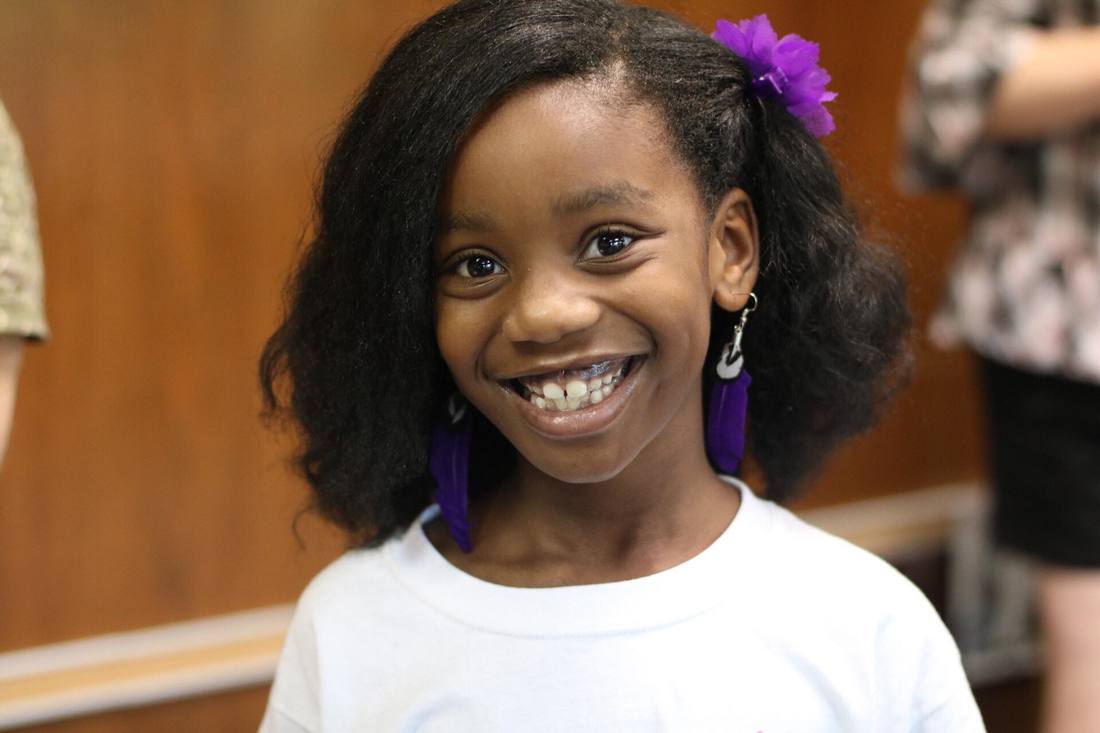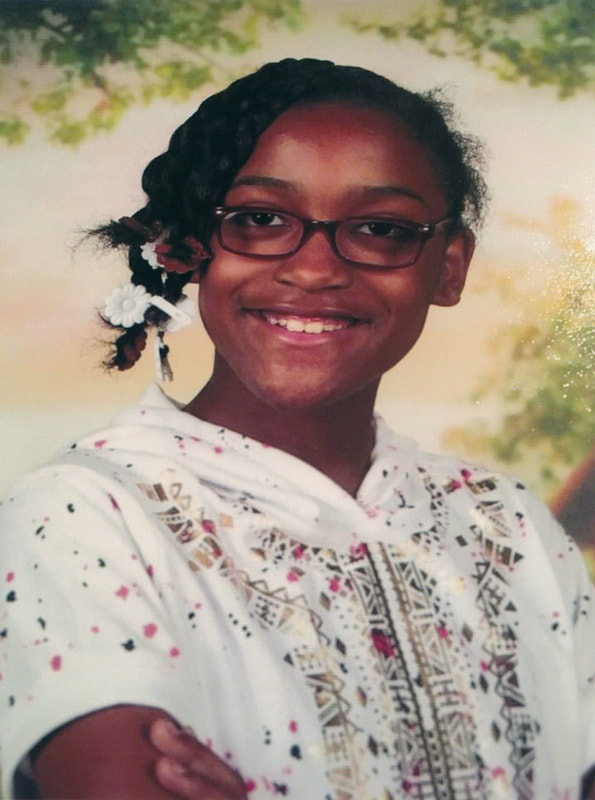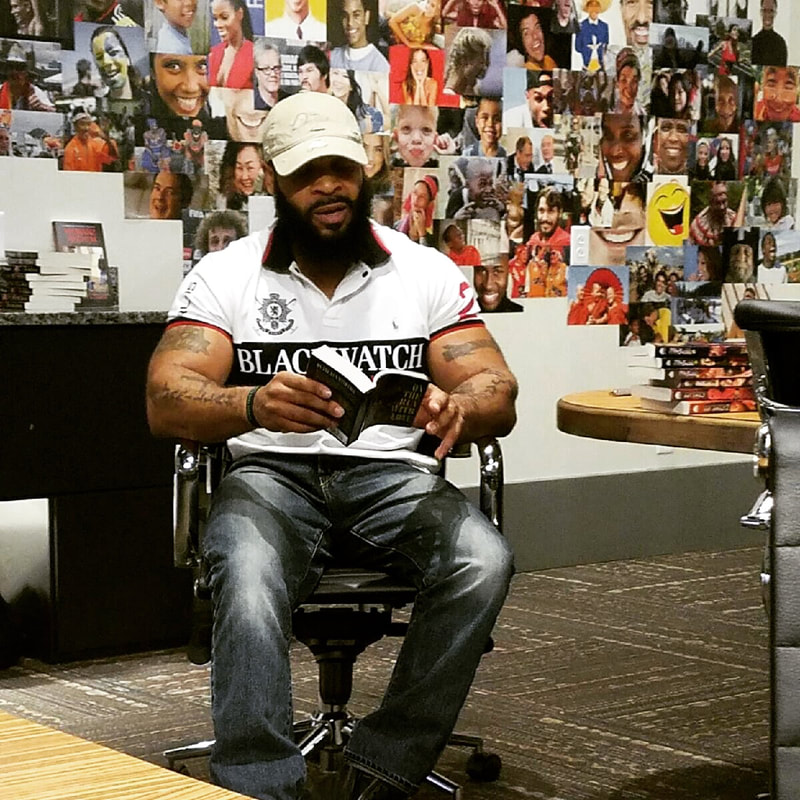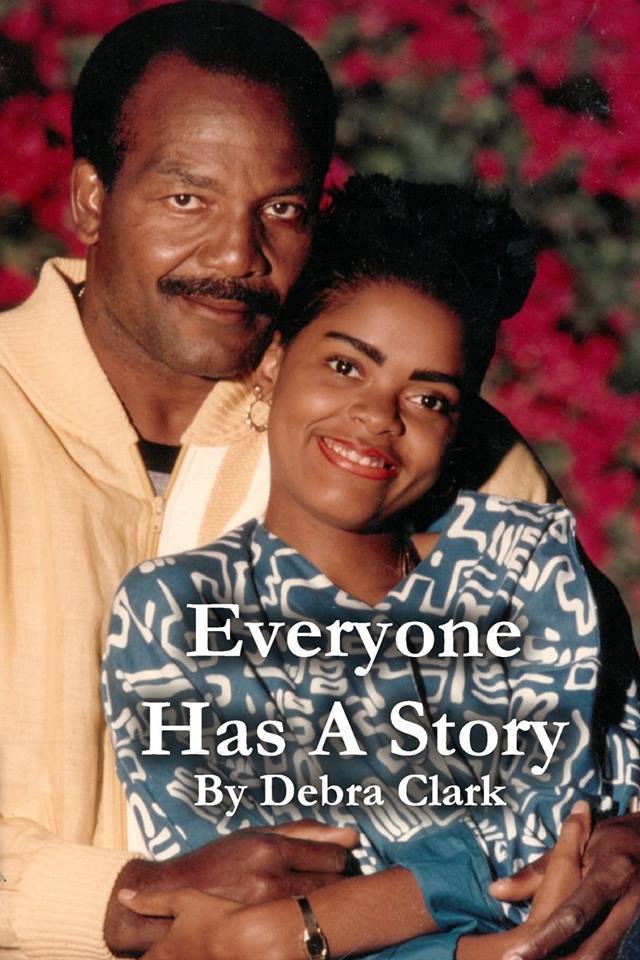|
Marcayah was born July 11, 2009 to Marcus and Erica Carter. She is the youngest of three children, and the only girl. She’s an energetic little girl who spends her time at home playing with her brothers, Marcus Jr. and Enijah, flipping around the house, and playing on her laptop.
Marcayah is currently a student at Dorseyville Elementary School. Her favorite subject is math. At school, not only is she an honor student, she is a member of 4-H and is on the DES cheer squad. She became an author after she decided to follow in her mother's footsteps. Aside from writing, Marcayah says she would like to be a teacher, doctor, or beautician when she gets older. She would also like to be a gymnast. Whatever path she decides to take, she’s determined to give it her all. About her book, "Don't be a Bully" Bullying has become a nationwide problem. Oftentimes, young children are bullied by people who they considered their friends. In this story, Olivia and Mya start off as best friends, even spending nights at one another’s house, but jealousy gets in the way and changes that. Without warning, Mya starts treating Olivia differently and she has no idea why. Her feelings are hurt, but she tries not to let Mya get to her. Her attempts fail because, eventually, Mya’s bullying affects her in the worse way. Mya won’t understand how her actions affect others until she’s the one being bullied.
1 Comment
Los Angeles, CA | July 4, 2018
by Danielle Leach The Origin of FDMG Academy Vision At the end of 2013, Dr. Umar first introduced the idea of opening up a residential academy for Black boys at the Meeting of the Minds (Think Tank) in Norfolk, Virginia meeting. During this meeting, Dr. Umar and members of the Black community brainstormed different schools that were up for sale and available which would make a good location for the FDMG RBG Academy. One of the schools was St. Paul's College. Saint Paul's College is a historically Black college in Lawrenceville, Virginia opened in 1888 by James Solomon Russell, freed slave and friend of Booker T. Washington. The school started with a dozen students and gained a steady enrollment over time. St. Paul's last graduating class was in June 2013. One day, Dr. Umar received a call saying that St. Paul's would be going up for auction. Dr. Umar called the president of St. Paul's College to negotiate a bid on the college for $3 million. They wanted 4% down (~$150,000 down payment). The college didn't sell at the auction. So Dr. Umar was invited to visit to negotiate a deal. Why St. Paul's? 90 miles from Richmond. 90 miles from North Carolina border Southern Virginia 137 acres (of 500 acres. They sold 300 acres, which Dr. Umar initially intended to build a Black Wall Street on the excess acres). “Black Wall Street” would consist of teacher and parent houses, a gas station, supermarket, daycare, cleaners, fire department, police department. The ultimate vision? To incorporate into a city. The school would be the “foundation for a 21stcentury Black Wall Street Operation” proclaims certified School Psychologist, Dr. Umar Ifatunde. The school is “small enough for a college, but big enough for the vision.” It has dormitories, brand new state of the art student center (built by alumni), a gymnasium cafeteria, and most importantly it's surrounded by undeveloped acres in a rural area, enclosed by an African-American community. The operating expenses were reported at $40-$60,000/month. While on the tour, Dr. Umar was told by the realty company that he had until July-August to raise 2.5 million dollars. FDMG Academy Fundraiser began on May 20, 2014 and nearly $150,000 was raised in 30 days. School Objective: To teach youth knowledge of self (African Identity) and leadership Key Curriculum Components: Core: math, science, social studies, language arts Agricultural science (farm) Raw Food* Organic (no oven, microwave, or stove) Natural Hair care Clothing Manufacturing Hospitality/Tourism/Hotel and Restaurant Management Financial Economic (9th grade taxes*, 10th grade real estate, 11th grade business plan, 12th grade stock market/multi-trading, international commerce) Military science (how to survive off the land) To Make a donation, make checks payable to: FDMG Academy P.O. Box 6872 Philadelphia, Pennsylvania 19132 [email protected] Include name and mailing address so you can be honored for your donation. If you contribute $1000 or more, you will be named as one of the founding mothers/fathers. To apply: Send resumes to [email protected]. African-centered, pro-heterosexual applicants are encouraged to apply. Degree required: -certified math teachers, science, social studies, language arts (bachelor's degree required; 18 college credits specific to content area you will be teaching at the school) -social workers, nurses, building engineers, stock brokers, economists Degree not required: special skilled jobs secretaries security guards natural hair care stylists organic/raw food chefs farmers janitors painters bus drivers classroom assistants Other cities of interest: Chicago, Detroit, Atlanta School suggestions? Send your school suggestions to Dr. Umar Ifatunde via text at 215-989-9858 School specs: 500-3000 student capacity Source: https://www.youtube.com/watch?v=AyFuIfSPml4 Copyright 2017 Danielle Leach All Rights Reserved
Characteristics and Prevalence of ODD The Diagnostic and Statistical Manual for Mental Disorders (DSM-5) classifies Oppositional Defiant Disorder as a disruptive disorder typically diagnosed in childhood, among Intermittent Explosive and Conduct Disorders (American Psychiatric Association, 2014). It is one of the most stigmatizing disorders that a child or adolescent can receive and is reported to be the number one cause of referrals to youth mental health facilities (Nock, M.K. et al, 2007). Historically, ODD was associated with youth delinquency in the DSM-II and was broken down into the following three subtypes: runaway reaction, unsocialized aggressive reaction, and group delinquent reaction; whereby all three subtypes were explained by environmental factors (Pardini, D.A, et al, 2010). The unsocialized aggressive subtype, described in the DSM-II in 1987 consisted of behavior in children that was seen as hostile, aggressive, and disobedient, and was primarily due to parental neglect and lack of effective parenting and disciplinary control (Pardini, D.A, et al 2010). Conceptualization of ODD – unsocialized aggressive subtype is similar to the current understanding of ODD, described in the current DSM-5. Despite advances in the DSM-5 to make the criteria more specific and reliable, the current conceptualization of Oppositional Defiant Disorder is purported to be too general and broad in nature, making it easier to over-diagnose children and adolescents who wouldn’t otherwise meet the criteria (Grimmett, M.A., 2016). According to the DSM-5 criteria for Oppositional Defiant Disorder, any child who is angry, loses his temper often, blames others for his or her mistakes/behavior, or refuses to obey and respect authority, would meet the criteria for ODD (American Psychiatric Association, 2014). To receive a diagnosis of ODD, the symptoms must be observed by someone who is not a sibling (American Psychiatric Association, 2014) – which is typically the child’s teacher at school - and must persist for at least 6 months, appear at least once per week, and cause distress to the client or others in the client’s environment (American Psychiatric Association, 2014). Other symptom criteria include: irritability, annoying others, and being vindictive/spiteful (American Psychiatric Association, 2014). Understanding how the diagnosis of ODD has been formulated and conceptualized over the years is important to understanding how the disorder can become a crutch for school psychologists, teachers, and clinicians who work directly with children who exhibit problem behaviors. The American Academy of Child and Adolescent Psychiatry (2009) views Oppositional Defiant Disorder as a byproduct of various biological, psychological, and social contributing factors. Some of the biological factors that make a child more susceptible to acquiring ODD include the following: having a parent with a history of ADHD, ODD, Conduct Disorder, Substance Abuse Disorder or Mood Disorder; having traumatic brain imagery or impairment in the region of the brain responsible for impulse control and decision making; toxin exposure; and poor nutrition (American Academy of Child and Adolescent Psychiatry, 2009). Psychological factors linked to ODD include having an absentee or neglectful parent and poor social skills (American Academy of Child and Adolescent Psychiatry, 2009). Last, but not least, several social and environmental factors have been identified as possible causes of ODD that include poverty, growing up in an adverse environment, and parental divorce (American Academy of Child and Adolescent Psychiatry, 2009). While the definitive cause of ODD in children and adolescents remains unknown, it’s reasonable and helpful to conceptualize ODD as a disorder that occurs in the context of maladaptive environmental factors and social influences. Diagnosis of ODD in African-American Boys A qualitative study conducted by researcher and doctor, Marc A Grimmett uncovered some of the contextual factors and diagnostic processes of licensed mental health professionals when assessing, diagnosing, and treating clients with ODD (Grimmett, M.A., et al, 2016). The study consisted of in-depth interviews, which lasted approximately 1.5 hours and what he and his research team found concerning the process for which clinicians were assigning mental health diagnoses was quite alarming. The results of the data analysis showed that there were four domains that influenced the clinician to assign a diagnosis of ODD to a client which included: managed health care/insurance demands; ODD criteria being too broad; stigmatization of ODD; and counselor bias in assessment that excludes cultural/external factors (Grimmett, M.A., et al, 2016). The researchers found some consistency in responses given by the clinicians in the study across these four domains in which they were assessed, suggesting that there could be some external and internal factors within the therapist and within the context of the system in which he or she practices that directly influence his/her decision to assign a diagnosis of ODD. Since the criteria for ODD in the DSM is broad in nature, it serves as a “catch-all phrase” for clinicians who may not quite be able to put a finger on why their student is misbehaving or acting out in class. One participant in the study described it as a “holding cell for behaviors that are not understood” (Grimmett, M.A, et al, 2016). This points to a major problem with the use of the DSM by clinicians who are culturally incompetent and who rely heavily on the DSM as a tool for labeling as opposed to an instrument for assessing, understanding, and conceptualizing. Many clinicians are so hard pressed to end each intake session with a diagnosis that they forget to do a complete, comprehensive evaluation, taking into account family, social, and cultural influences that could be impacting their client’s symptomology. Cognitive Affective Symptoms of ODD According to the American Academy of Child & Adolescent Psychiatry (2009), “difficulty or inability to form social relationship or process social cues,” is a likely leading contributing factor leading to the development of Oppositional Defiant Disorder. Although the development of ODD can be conceptualized in the context of the child’s social environment, it’s also helpful to see the cognitive aspects of behavior that impact ODD symptomology. Two theories serve to be very helpful in investigating the cognitive-affective role and relationship in the presentation of ODD, which include Appraisal Theory and Network Theory. According to Appraisal Theory, “Unconscious appraisal of stimuli takes place prior to the emotion whereas conscious attribution of the emotion to a cause and/or labelling of the emotion (e.g., as fear or anger) takes place after the emotion” (Houwer, J.D., 2010). Under this principle, emotions can be understood as happening both on the subconscious and conscious level. So that it’s likely that some emotions we experience happen in response to stimuli from our environment that we aren’t always aware of. Take for example the stimulus of the colors red and yellow. Typically, red and yellow are known to evoke a feeling of hunger in us, which happens on a subconscious level that we are unaware of. On the contrary, some emotional experiences happen more on a cognitive level (i.e. a person getting angry when they become aware that their rights have been violated). Differentiating between emotional responses that are conscious vs unconscious lends very important information for clinicians when treating disorders that encompasses an element of emotional dysregulation, a mechanism that is in within the client’s control. Network Theory provides another explanation for understanding the connection between cognition and emotion which assumes that “initially only a handful of biologically relevant stimuli elicit unconditioned emotional responses and that the range of stimuli that evoke these emotional responses is progressively elaborated through conditioning procedures” (Houwer, J.D., 2010). This is to say that the majority of emotional responses experienced by humans occurs through the process of conditioning and learning. So while emotional responses linked to our biological adaptations to the environment may serve to protect us in life-threatening situations, those emotional responses can be manipulated through social learning and conditioning. This reality can be comforting for many clients who struggle with the challenge of regulating their emotions, regardless of their social context or historical background. Within the premise of Network Theory lies the notion of schemas (Houwer, J.D., 2010), which are cognitive networks formed through learning and conditioning over time. To illustrate this idea, consider a teen who is being raised in a single parent household, with an absentee father, living in a crime-ridden, poverty stricken neighborhood. Over time, the teen may have learned to institutively put up his defenses and become combative and argumentative, in an effort to protect himself, his mother, and his family. His unique experience of growing up in a neighborhood where murder and violent crime are rampant has caused him to develop various cognitive schematic networks in his brain surrounding safety and survival that aren’t necessarily healthy adaptive mechanisms in other social contexts (i.e. school). These schematic networks will directly impact his overall perception and ultimately his worldview. So subconsciously, he makes the mistake of generalizing the conditions of his current adverse environment to all environments, that forces him to wear a protective psychological guard with him everywhere he goes. The world, through his eyes, is unfair, dangerous, and unsafe. This negative cognitive schema directly impacts his emotional state, leading him to feel a need to always defend himself, become easily annoyed and angry, and become confrontational with others. Cognition and affect are two inseparable systems that are constantly working together. What a person thinks inevitably affects how he or she feels. So it’s not unlikely for a kid who is experiencing parental neglect, poverty, and negativistic thinking to feel angry, isolated, and oppositional. It’s also not uncommon for a kid who is presenting with symptoms of ODD to endorse symptoms of other disorders, specifically ADHD, Mood Disorders, and PTSD (Boat, T.F., & Wu, J.T., 2015). The likelihood that a clinician will accurately assess and treat a person who has multiple diagnoses decreases as the number of presenting symptoms and provisional diagnoses increases. So the difficulty in being able to appropriately ascertain whether symptoms presented by a client are a function of his or her culture, environment, psychological state, or another diagnosis can present some serious challenges for clinicians working with children and adolescents with problematic behaviors. It’s much easier to narrow the etiological causes of these symptoms down to cognitive-affective factors that may help better explain the innerworkings of ODD. It takes the burden off of society and partially relieves the clinician of the responsibility to work from a cultural framework, therefore embodying more of a cognitive-affective, individualistic approach. Current Treatments for ODD The good news is that ODD is treatable and typically involves an interdisciplinary approach for optimum therapeutic outcomes. The American Academy of Child & Adolescent Psychiatry (2009) states that a combination of therapeutic approaches is necessary for the treatment of clients with ODD which include: parent training and family therapy, cognitive problem-solving skills training, social skills training, and medication (in severe circumstances). Cognitive problem-solving and social skills training typically involve a cognitive-affective component where the clients receive training on being able to identify and understand social cues (i.e. non-verbal communication, emotional expressions) and learn techniques and skills on ways they can better communicate and express their thoughts and feelings with others (American Academy of Child & Adolescent Psychiatry, 2009). Cognitive problem-solving involves teaching the child/adolescent how to make appropriate choices in stressful situations, which allows them the chance to learn emotional regulation, whereby they come to a greater understanding of how their cognition influences their emotion and behavior and vice versa. Such techniques have been used in camp settings, group therapy, and in the context of individual and family therapy. Proposal of Novel Treatment for ODD that address Cognitive Affective Component A treatment model that involves a multi-disciplinary approach and takes into consideration psychological, biological, cultural, social, and environmental factors that contribute to the onset, development, and maintenance of ODD would likely be most effective in treating children and adolescents with ODD. Current treatments typically fail to take into consideration cultural and societal factors when assessing and treating clients which often lead to over-diagnosis, stigmatization, and worsening of the symptoms (Grimmett, M.A, 2016). Having a sensitivity to cultural influences not only informs diagnosis, but it informs the process of therapy as well. It shapes how the counselor perceives and treats the client, whereby strengthening the relationship between client and therapist, or creating a divide. A counselor who views a kid’s symptoms as a matter of choice and free will may be insensitive to what their client is experiencing, thus taking a harsher more punitive approach in treatment. However, a therapist who views the client as a product of his or her environment and understands the social, political, and environmental factors that help influence the development of maladaptive behaviors will be more cautious in his/her approach to working with the client and less likely to judge them by their inappropriate behaviors. This distinction points to one of the most important aspects of therapy – the therapeutic relationship – which lays the foundation for everything else that happens thereafter. An understanding of the client’s problem through a socio-cultural lens is important to the success of therapy, but isn’t all encompassing. There still needs to be a level of responsibility taken on behalf of the individual client, so this is where the cognitive-affective component comes in to play. Utilizing an approach that has a healthy balance within the cognitive-affective-socio-cultural framework would be optimum for treating a client with ODD because they give the power back to the client, while at the same time, not undermining the significance that external factors beyond the client’s control play in leading them to come to a therapist’s office in the first place. Teaching a client about their emotions, makes them more cognitively aware and puts them in control of their own behavior. Being able to identify and recognize symptoms before they get out of control is also empowering for the client who has a history of reacting to social situations in an impulsive, aggressive manner. Creating a treatment protocol that teaches the client mindfulness, relaxation, and impulse control appears to be a likely effective approach in working with a client who has trouble regulating their emotions, which is typical for children who present with ODD. Psychoeducation has been used with a variety of client populations from various socio-economic statuses and educational levels, and can be effective when the curriculum is adapted to the client’s cognitive level and ability. Lastly, incorporating opportunities where youth can express themselves outside the context of therapy, and in the real-world, whether it is through art, music, dance, or sports can also be effective. Typically, when an individual attempts to assert their rights and power, when they feel powerless, they do it by resisting the “system,” which would include authority figures like teachers and law enforcement. So, in theory, it’s likely that children who come from oppressed families and communities are more likely to be engaged in behavior that makes them feel “powerful.” For teenagers, these behaviors typically are risky in nature and include drug use, promiscuity, breaking the law, and the list goes on. So directing them to positive outlets that support and encourage emotional expression would be beneficial and necessary. It’s one thing to spend an hour a week with a child telling them the appropriate way to think, act, and behave; it’s another thing to be able to direct them to resources that provide opportunities for them to shine. More often than not, children enter therapy just to return to a bad environment that overpowers the effect four hours per month of therapy has done anyway. So the approach one takes in working with one client from one demographic, may be much different than the approach and techniques used with a client from another demographic, age, and socio-economic status. The important thing to take away from this is that behavior, to a certain extent, is within an individual’s control. Meeting the client where he or she is at through empathic listening and maintaining a non-judgmental attitude is the first step; broadening their understanding of the world and themselves, within the context of a cognitive affective approach, would be the next. Helping them create new healthy schemas in their brain that allows them to be more functional and adaptive in the world could serve them well; and the reality that the client’s environment (which they may or may not have control over) is always constantly shaping how they think, feel and behave should always be in the back of the therapist’s mind when working with a client who presents with ODD. References American Psychiatric Association. (2014). Desk Reference to the Diagnostic Criteria from DSM- 5. Washington, DC. American Psychiatric Publishing. pp 219-220 Boat, T.F., & Wu, J.T. (2015). Mental disorders and disabilities among low-income children. Washington, D.C.: National Academies Press; chapter 7 Grimmett, M.A., Dunbar, A.S., Williams, T., Clark, C., Prioleau, B., & Miller, J.S. (2016). The Process and Implications of Diagnosing Oppositional Defiant Disorder in African American Males. The Professional Counselor, 6(2), 147-160. Doi: 10.15241/mg.6.2.147 Houwer, J.D. (2010). Cognition and emotion: reviews of current research and theories. New York, NY: Psychology Press. pp 13, 18 Nock, M.K, Kazdin, A.E., Hirpi, E., & Kessler, R.C. (2007). Lifetime prevalence, correlates, and persistence of oppositional defiant disorder: results from the National Comorbidity Survey Replication. Journal of Child Psychology and Psychiatry, 48(7(, 703-713. doi: 10.1111/j.1469-7610.2007.01733.x ODD – American Academy of Child and Adolescent Psychiatry. (2009). Retrieved July 6, 2017, from www.aacap.org Pardini, D.A., Frick, P.J., & Moffitt, T. E. (2010). Building an evidence base for DSM-5 conceptualizations of oppositional defiant disorder and conduct disorder: Introduction to the special section. Journal of Abnormal Psychology, 119(4), 683-688. doi: 10.1037/a0021441 Diagnosing ADHD & ID in African-American Children
Danielle Leach, M.S. Los Angeles, California Prevalence of ADHD & ID in African-American Children Attention Deficit Hyperactivity Disorder, often referred to as ADHD stands as one of the most commonly diagnosed disorders among children in America. Despite the significant amount of research conducted on ADHD surrounding diagnosis and treatment, there has been very little evidence that lends enough information to determine a definitive cause. To that end, many parents who are told that their child meets the criteria for the disorder, struggle with accepting the label of the diagnosis in the absence of an explicit cause or explanation as to how their child developed the disorder in the first place. The rate of diagnosis of ADHD in children has been steadily on the rise over the past decade and continues to rise simultaneously as the criteria for diagnosis of ADHD becomes looser with the release of each new edition of the DSM (Diagnostic & Statistical Manual for Mental Disorders) (Joyce Cheng, "Arguments about Whether Over-diagnosis of ADHD is a Significant Problem"). This increase can be explained by a number of contributing factors, including the following: (1) over-diagnosing (2) lack of continuity of care (3) loose criteria (4) increasing consumer demand and (5) clinician bias (Joyce Cheng, "Arguments about Whether Over-diagnosis of ADHD is a Significant Problem"). Matched with the overall prevalence of ADHD diagnosis in children in America stands a higher prevalence of ADHD with hyperactivity subtypes diagnosed in African-American children (Root & Resnick, 2003). This raises the question as to whether ADHD in African-American children is being over-diagnosed by clinicians or if more and more children are actually presenting with symptoms that meet criteria for the diagnosis. The complexity in resolving such problem is predicated on the reality that diagnosis of mental health problems in a marginalized population is highly likely related to the systemic pressures put on teachers and school psychologists to discriminate against children of color, leading to classroom segregation and over-placement of African-American children in special-education classes. The higher prevalence of ADHD in African-American children still speaks to a bigger problem in our nation, with an underlining reality that more children are diagnosed with ADHD in America than any other country (Joyce Cheng, "Arguments about Whether Over-diagnosis of ADHD is a Significant Problem"). Despite our nation’s reputation of being a leader in health and education, many of its citizens are falling victim to the pitfalls of democracy and politics, as they remain the driving mechanisms by which these systems operate. The current rate for ADHD diagnosis in America stands at 11% and continues to rise as more and more generations of children are funneled through the system (Joyce Cheng, "Arguments about Whether Over-diagnosis of ADHD is a Significant Problem"). So while causes of ADHD in children remains unknown, there are several hypotheses for how African-American children are at a higher risk for attaining the disorder. One possible explanation for the higher prevalence of ADHD in African-American children has been linked to environmental influences, namely socio-economic status of the family to which the child is directly influenced by (Joyce Cheng, "Arguments about Whether Over-diagnosis of ADHD is a Significant Problem"), making children who attend schools in neighborhoods with families represented by low socio-economic status (SES) more susceptible to the diagnosis. Taking a closer look at the diagnostic criteria for ADHD, one can understand how a child’s socio-cultural environment can be a contributing factor to shaping the onset of the disorder. The DSM states that a child has to endorse either 6 of the Inattention symptoms and/or 6 of the Hyperactivity symptoms for a period of 6 months in order to meet the diagnostic criteria for ADHD (Diagnostic and statistical manual of mental disorders: DSM-5, 2013, pp. 59-60). The symptoms must begin onset before age 12, be evident in two or more settings, and cause significant distress or impairment in functioning (Diagnostic and statistical manual of mental disorders: DSM-5, 2013, pp. 59-60). Some of the symptoms included in this criteria that could possibly be explained by socio-cultural and environmental factors include the following: difficulty in sustaining attention on tasks; difficulty with organizing tasks; avoids participating in tasks that require sustained mental effort; often loses things required to complete tasks; forgetful and easily distracted; being fidgety; leaving seat when expected to; unable to play quietly; unable to sit still; excessive talking; blurting out answers and not giving others time to complete their sentences; interrupting others; and having difficulty waiting turn (Diagnostic and statistical manual of mental disorders: DSM-5, 2013, pp. 59-60). So in essence, what may by perceived by one group of people as disruptive, inappropriate, and abnormal behavior, could simply be a representation of cultural differences between ethnic racial groups, high influenced by their socio-cultural environment in which they live in. Interpretation of these behavioral characteristics are predicated on whether or not the person making the observation views the behavior as a function of one’s culture and environment as opposed to an inherent trait that underscores a specific deficit in the individual. The fact that there’s a higher prevalence of ADHD diagnosis in low SES schools (Root & Resnick, 2003) speaks more to racial disparities than it does income status, given that the majority of low SES families are represented by people of color. Within poor families, exists issues surrounding poor nutrition and diet which could also provide possible explanations for the hyperactivity and inattentiveness. Essentially, it would be very difficult for anyone to remain attentive and productive at work or school when there are concerns about one’s health and safety that linger constantly in their minds. Nevertheless, it is one’s cultural adaptation to these socio-economic problems linked to racial oppression and discrimination that also have a detrimental impact within every individual who is affected. More specifically, within the African-American culture, it isn’t uncommon for a person to finish another person’s sentence while they are speaking, especially when the person speaking is having trouble formulating the words they’re trying to say. This linguistic difference seen within the African-American culture may come off as strikingly problematic in the context of a culture that highly values verbal ability defined by “appropriate” pronunciation, articulation, and subject-verb agreement. Even within many African-American churches, you will find a style of worship that is very different than what you will see in white churches where the congregation will interact with the pastor by “blurting out” phrases like, “Yes!” “Preach!” “Praise God” to encourage the pastor to continue preaching and serves as minimal encouragers to let the pastor know that the church is following what he’s saying. These slight nuances in communication speak to cultural differences between Blacks and Whites that are not yet recognized and understood by mainstream culture, especially as it relates to the educational school setting. Because Blacks within American society are seen as a numerical minority group, a lot of behaviors that are normal within this subgroup are pathologized within the greater context of the dominant culture. As a result, the diagnostic criteria and labels of ADHD in the DSM are problematic for many clinicians because they are unclear and confusing (Root & Resnick, 2003). You can take 10 different clinicians, hand them one African-American child, and they will all come up with 10 different diagnoses. This is mostly due to the fact that the criteria in the DSM is very vague, too broad, and all-encompassing. Clinicians are met with a very challenging task of assessing pathological symptoms in clients that cause distress for the individual, but with respect to the diagnosis of ADHD, the symptoms are more a distress for the people in the individual’s life (namely the teachers and parents) than they are for the child themselves. Dr. Umar Johnson, a Certified School Psychologist in the state of Pennsylvania who specializes in early childhood assessments indicates that there is a very high prevalence of ADHD diagnosis in African-American boys in public schools that is mostly linked to environmental causes, that he has coined, “Ain’t No Daddy at Home Disorder.” In his book, “Psycho-academic Holocaust: the Special Education & ADHD Wars against Black Boys,” Dr. Umar emphasizes the importance of the role of positive male role models and having a father figure to the healthy development of a child’s life (Johnson, U., 2013). The numbers of African-American children being raised in single parent households is alarming and has become a topic of increasing concern for change agents within the Black community. Disproportionate and Over-representation of African-American Children in Special Education Alongside the over-representation of ADHD in African-American children sits a disproportionate representation of Intellectual Disability (ID) diagnoses in African-American children. Despite studies with attempts to disprove the over-diagnosis of ID and ADHD in African-American children (Norman, Staff, Hillemeier, Farkas, & Maczuga, 2013), research has shown that African-American students are being diagnosed with an intellectual disability at a right that is twice as high than White students (Gentry, "Disproportionate Representation of Minorities in Special Education - How Bad?", 2009). As a result, the similar questions relating to the over-diagnosis of ID in Black students, much like ADHD arise. Under Section 504 of the 1973 Rehabilitation Act, children have the right to be afforded a quality and equal education (Root & Resnick, 2003) Under this Act, students should receive a multidisciplinary diagnosis and be afforded an appropriate individualized education plan (Root & Resnick, 2003). Despite legal regulations to enforce equality in education for African-American students, they are still met with challenges of racial disparity and discrimination in the educational school setting. Over-representation of African-American students with intellectual disabilities has been attributed to: the classroom environment, family and environmental stressors, characteristics of the student, bias in standardized testing and curriculum, and teacher perceptions and attitudes (Gentry, "Disproportionate Representation of Minorities in Special Education - How Bad?", 2009). The most important and distinguishing factor that concerns many Black affirming clinicians is the biases presented in standardized testing and curriculum. In taking a deeper look at the disproportionality of African-American students in special education, test bias stemming from language barriers and economic disparity and disadvantage appears to be the most influential (Skiba, et al., 2008) Problems with Diagnosis Operationally Defining Intelligence and ADHD The problem with diagnosis of ADHD and ID (Intellectual Disability) in children is rooted in the way in which the two are defined and measured. The two constructs are operationally defined in the context of a society that has a long history of racial oppression and discrimination. On one hand, being able to identify and define a given problem in society can be beneficial, pointing us to possible solutions for how the problem can be fixed; but on the other hand, the way in which a problem is defined can cause more harm than good to every individual affected by the problem. With respect to the current diagnostic criteria for ADHD and ID in the DSM, it is very clear that there is a system designed to separate a group of individuals who deviate from the norm. So at the end of the day, it doesn’t matter how or why they are different; what’s most important is that they are different and their difference is essentially causing a problem to society. Instead of appreciating the differences in individuals, we’ve become attuned to pinpointing and labeling those differences, putting those who are significantly different and don’t fit into society’s standard of normal in a dehumanizing box of their own. Methods of Diagnosis The method in which ADHD and ID are diagnosed speaks to why so many children, specifically African-American children meet the diagnosis. Efforts to make diagnosis more valid, reliable, and fair point to the need for differential diagnosis (Warner-Metzger & Reipe, "Disruptive Behavior Disorders in Children and Adolescents", 2013). So essentially, in terms of diagnosing ADHD, there needs to be a more defined way of interpreting and understanding behaviors presented by African-American children in classrooms. Before making a diagnosis of ADHD-hyperactivity subtype to a child who seemingly meets the diagnosis of ADHD as defined by the DSM 5, a well-trained clinician should assess whether there are instances where the child is able to sit still and complete tasks and under what circumstances as opposed to only looking for instances when the child is having difficulty sitting still, because there is a distinct difference. It could be that the child is able to sit for long periods of time and attend to a task in an environment that is supportive of his learning style when he is given a task that the child finds meaningful and enjoys. The expectation of discipline for children to sit for a lengthy time in a classroom may be unrealistic for most children who appreciate interactive and engaging activities that include physical movement. Likewise, instead of giving a child an intelligence test, like the WISC, which was originally normed on a group of White children, to assess their intelligence, clinicians should utilize culturally sensitive measures that accurately measure cognitive ability as opposed to verbal ability, which in part is biased toward European English speakers. Although many African-American children are taught English in their family household and in the schools, clinicians must be mindful that there still exists a language barrier for many African-Americans, much like there is for immigrants to whom English is their second language. As an African-American, I can assert that speaking “proper English” comes as a challenge for many African-Americans, as it still remains the language of our oppressor and a tool used to further oppress a group of people who come from a lineage of slaves where English was not their native language. Effects of Diagnosis The impact of mis-diagnosis of ID and ADHD in children can have very profound effects. Restricting a student to a certain academic setting, such as special education classes, can limit his or her learning potential making it problematic for the developing child to compete in a global marketplace (Codrington & Fairchild, 2012). More specifically, the placement of students in special education can lead to the reverse effect than initially intended, causing them to adopt similar characteristic of children with disabilities which could lead to an increase high school dropouts, police arrests, decreased employment, and a lesser chance of independent living (Codrington & Fairchild, 2012). Dr. Umar Johnson speaks on the school to prison pipeline in his book, “Psycho-academic Holocaust: the Special Education & ADHD Wars against Black Boys,” suggesting that public schools are designed to weed out African-American boys by labeling them with ADHD, ODD, and other conduct disorders, which inevitably shape the child’s identity (Johnson, U., 2013). So essentially, these special education classes becoming a “holding cell” for the African-American students that many culturally incompetent teachers have wrote off as bad apples. Other effects of over-representation of African-American students in special education include lesser academic expectations and stereotyping (Edwards, O.W., 2006). When African-American students are labelled learning disabled, they feel a sense of lowered self-esteem (Hamilton & Astramovich, "Counseling Children with ADHD: Three Focus Areas for Professional Counselors"). A threat to one’s self-concept and identity will inevitably affect the way in which they are perceived by others in the world and ultimately determine their place in society. Reconceptualization of ADHD and IDD in African-American Boys Interdisciplinary Approach to Diagnosis Considering the issues with bias in testing and assessment, leading to an over-diagnosis of ADHD and ID in African-American children and disproportionality of African-American students in special education classes, it is likely that an interdisciplinary approach to diagnosis is warranted to ensure proper and fair treatment of African-American students in the classrooms. This entails having a consultation with medical doctors, pastors, community leaders, and Black affirming mental health advocates before a permanent label of ADHD or ID are assigned to a child. As it stands, a psychologist can diagnose ADHD, a disorder that is considered to be a deficit in one’s brain, without the aid of a physician or medical doctor. Much like depression is understood as a deficit in serotonin in the brain and can be diagnosed without a CAT scan of the brain, the same ill-informed practice is happening with mental health diagnoses rooted in one’s genetic and biological makeup. Preventing Over-Diagnosis Teacher training, behavior management strategies, early prevention, less bias testing, increased family and community engagement, and policy reform are all likely solutions to preventing or reducing over-diagnosis of ADHD and ID (Skiba, et al., 2008). If research has already found that clinicians are biased in their assessment of psychological researchers, teacher training in cultural diversity may prove to be a likely solution. However, cultural diversity training isn’t the end all be all, because with training also comes the threat of external socialization that the teachers are affected by in a broader context. So teachers and clinicians can go through hours of cultural diversity training to make them more aware of the differences in culture between students of various racial ethnic backgrounds, but the training may not be as effective in curbing their inherent bias against children of color all together – given the overarching influence of a racially oppressive society propagandized by the media and politics. Therefore, advocacy on behalf of teachers, psychologists, and community leaders is paramount to reducing the likelihood of over-diagnosis and over-representation of African-American students in special education classes (Codrington & Fairchild, 2012). While teacher training is useful, it isn’t sufficient. Addressing test bias in a more concrete manner also plays an integral role in preventing over-diagnosis. Clinicians should ask the following questions: Do tests have high construct validity? Do they measure what they purport to measure? (Reynolds & Suzuki, 2012). Many researchers and clinicians alike are advocating for the development of testing and assessments that are more culturally sensitive and appropriate for the demographic they are being used on (Reynolds & Suzuki, 2012). The No Child Left Behind Act puts the responsibility on the teachers to ensure their students are grasping the material (Land, M.Y, 2015). If students aren’t meeting the curriculum standards set by the school district, then it becomes the teacher’s job to ensure that their student receives the proper educational plan that supports their style of learning. The challenge comes in developing an educational plan that addresses any learning deficits the child may be experiencing while at the same time, making sure the child isn’t being discriminated against by being placed strategically in segregated classrooms that make them feel inferior, unequal, and less intelligent. So ultimately, school psychologists are tasked with the responsibility of reducing the number of African-Americans over-represented in special education classes ("Racial and ethnic disproportionality in education", 2013). Issues surround blaming the victim versus blaming the system arise when attempting to develop solutions to the problem of over-representation of African-American children in special education classes ("Attention Problems: Intervention and Resources", 2015). We live in a society that promotes freedom of individual choice and responsibility in the face of systemic oppression and discrimination. Finding a balance between the two can be quite alarming and perplexing. Overall effective solutions to curbing the disproportionality problem in public schools involve a systemic approach that include the following: Getting family involved in prevention and intervention (Carr, A., 2009); Multi-cultural training and education for educators working with African-American youth (Ford, B.A., 1992); taking a strength-based approached in promoting achievement, ethnic identity, and skill-building in African-American youth (Ford, D.Y. "Counseling Gifted African American Students: Promoting Achievement, Identity, and Social and Emotional Well-Being", 1995); and more importantly, teaching through learning styles i.e. expressive arts, poetry and music, drama, puppetry, writing, and drawing (Ford, D.Y. "Counseling Gifted African American Students: Promoting Achievement, Identity, and Social and Emotional Well-Being", 1995) Copyright Danielle Leach 2017 All Rights Reserved References: Attention Problems: Intervention and Resources [Pdf]. (2015). Center for Mental Health in Schools at UCLA. Carr, A. (2009). The effectiveness of family therapy and systemic interventions for child-focused problems. Journal of Family Therapy, 31(1), 3-45. doi:10.1111/j.1467- 6427.2008.00451.x Cheng, J. (n.d.). Arguments about Whether Overdiagnosis of ADHD is a Significant Problem[Pdf]. Los Angeles: National Center for Mental Health in Schools at UCLA. Codrington, J., & Fairchild, H. H. (2012). Special Education and the Mis-education of African American Children: A Call to Action [Pdf]. Association of Black Psychologists. Diagnostic and statistical manual of mental disorders: DSM-5. (2013). Washington, DC: American Psychiatric Publishing, pp 59-60 Edwards, O. W. (2006). Special education disproportionality and the influence of intelligence test selection. Journal of Intellectual & Developmental Disability, 31(4), 246-248. doi:10.1080/13668250600999178 Ford, B. A. (1992). Multicultural Education Training for Special Educators Working with African-American Youth. Exceptional Children, 59(2), 107-114. doi:10.1177/001440299205900203 Ford, D. Y. (1995). Counseling Gifted African American Students: Promoting Achievement, Identity, and Social and Emotional Well-Being [Pdf]. Charlottesville: The National Research Center on the Gifted and Talented. Gentry, R. (2009). Disproportionate Representation of Minorities in Special Education - How Bad? Lecture presented at The 3rd Annual Jane H. Leblanc Symposium in Communication Disorders in Arkansas State University, State University. Hamilton, N. J., & Astramovich, R. L. (n.d.). Counseling Children with ADHD: Three Focus Areas for Professional Counselors [Pdf]. American Counseling Association. Johnson, U. (2013). Psycho-academic holocaust: the special education & ADHD wars against black boys. United States: Prince of Pan-Africanism Publishing. Land, M. Y. (2015). School Psychologists Experiences with Assessment of Culturally and Linguistically Diverse Students. Philadelphia College of Osteopathic Medicine. National Association of School Psychologists. (2013). Racial and ethnic disproportionality in education [Position Statement]. Bethesda, MD Norman, P. L., Staff, J., Hillemeier, M. M., Farkas, G., & Maczuga, S. (2013). Racial and Ethnic Disparities in ADHD Diagnosis from Kindergarten to Eighth Grade. Pediatrics, 132(1), 85-93. doi:10.1542/peds.2012-2390d Reynolds, C. R., & Suzuki, L. A. (2012). Bias in Psychological Assessment. Handbook of Psychology, Second Edition. doi:10.1002/9781118133880.hop210004 Root, R. W., & Resnick, R. J. (2003). An update on the diagnosis and treatment of attention- deficit/hyperactivity disorder in children. Professional Psychology: Research & Practice,34(1), 34-41. doi:10.1037//0735-7028.34.1.34 Skiba, R. J., Simmons, A. B., Ritter, S., Gibb, A. C., Rausch, M. K., Cuadrado, J., & Chung, C. (2008). Achieving Equity in Special Education: History, Status, and Current Challenges. Exceptional Children, 74(3), 264-288. doi:10.1177/001440290807400301 Warner-Metzger, C. M., & Reipe, S. M. (2013). Disruptive Behavior Disorders in Children and Adolescents “I am an American. The reason is that black is a color and I have not been to Africa and as far as I know, my ancestors did not come Africa. I do not have anything against Africa and wants to go there some day but is afraid of all those shots that is needed. I am just an American child.”
My name is Bianca Pendleton and I am 10-years-old. I live in Hinesville Georgia with my family. I am a 5th grader at Taylors Creek Elementary School. I believe in giving back so I love to volunteer with my mom, brother and friends. I love spending time with my family especially my brother and my aunt net, net. I’ve been telling stories since I was 7 years old. I would wake up on Saturday morning and draw my ideas then I would ask my mom to type while I tell her the story behind the pictures. I love reading, writing and drawing because they help me relax. My favorite animal is a cat, my favorite color is purple and my favorite food is bacon. When I am not busy reading, writing or drawing, I love to dance around the house and play dress up. I love writing “The Delivery Girls series and I hope you enjoy reading them. Book Synopsis: Join three girls as they go about their first mission as delivery girls for the post office: to deliver a toy train to a little boy across town. However, the mission sounds simpler than it truly is, as the three delivery girls run into several obstacles along the way. Will they be successful in their first job as delivery girls? You’ll have to read to find out! The Delivery Girls: A Toy Train is a fun story with challenges that young children will find enthralling. Read this book with your little ones, and see how their eyes light up when the three delivery girls find a glove stand selling gloves with superpowers…or when they try to stop a burglar from harming a little boy! The excitement doesn’t stop until the last page. Instagram- Biancapendleton Facebook- https://facebook.com/kidauthor/ Book Link for book 2 https://www.amazon.com/dp/1641110376/ref=tsm_1_fb_lk Book Link for Book 1 https://www.amazon.com/dp/1944313168/ref=tsm_1_fb_lk “I would identify myself as African-American because black is a color and my skin is brown!”
I was born and raised in Chicago Illinois where I still reside. I’m seasoned author signed to Mz. Lady P Presents. I started reading urban fiction books when I was a teenager and fell in love with the creativity that the authors put into the books. I wrote my first book in 2015 and haven’t put my pen down since. I look forward to sharing my work with the world, be on the look out for Dedra. B!!! Book Synopsis: Chelsea is nothing more than a twenty-year old boss. She paved the way for many young hair stylists by opening multiple hair salons throughout Chicago. With her main focus being her business, and trying her best to cope with the tragic death of her father who was Murdered in cold blood right in front of her, having a personal life is the last thing on her mind. That is until she crosses paths with the infamous La’Cari Gibson. La’Cari is in a lane of his own, being born into money meant nothing to him. He still put in the work to make sure his famille’s businesses ran smoothly. True to his wife Zoey, he made sure no other woman could even come close to replacing her and she knew it. Loyalty means everything to him, but once you break that, nothing will stop him from returning the gesture, no matter who you are! Zoey is the true definition of a trophy wife, young, beautiful, and well kept. She stands behind her husband in the most expensive stilettos, purchased directly from his account. Unlike La’Cari loyalty means nothing to Zoey if the money isn’t flowing, and she will stop at nothing to secure her and her man’s bag. Watch as this drama filled story unfolds, when lies, loyalty, and marriages are broken! Love can be a dangerous game, especially when you don’t know the consequences behind losing. “I prefer to identify myself as an African American because of all the past hurt and pain our ancestors from Africa had to deal with from Africa to make a way for people like myself to live a life of freedom with no limits.”
Christy Sanderson is an author, entrepreneur, and public speaker. She has authored three other books, Woman of God Who Did God Create You To Be, From Nothing into the Woman of God: Spiritual Life and Woman of God Stop Looking for Love. Christy has been featured on the cover of UBAWA Magazine, and several radio interviews. She was once a Co-Host on the Digital Breeze radio show in Atlanta, Georgia. At the young age of 23, Christy fully committed herself to God, letting Him take total control of her life, and started her own ministry, Glory Nation. Her life purpose is to experience and share God's Glory, to fulfill God's promises, and to help others become closer to Jesus Christ to find their life purpose. Book Synopsis Who is this small-town girl? Where do she come from? What's makes her so special or different from me? Find out how this small-town girl moved from Mississippi to Atlanta with no job, no money or nothing! How she went from sleeping on a floor into prosperity? In this book Author Christy Sanderson reveals all her secrets, it's what you have been waiting for. It gives in depth key details on how she stepped out on faith with Boldness, didn't allow anyone or anything to block her from her destiny in life. Now Christy wants to know? Why do you allow the enemy to block your Blessings? Of course, we all know Why! It's because of FEAR! Now Christy will tell you how to remove the spirit of Fear out your life to reach your full potential when all odds are against you! Website www.glorynation.org “I am a descendent of Africans...Born in America, a man of color, so I am a Black man, with African blood flowing thru my veins but I am an AMERICAN citizen. Black is not a race rather a color. I am African AMERICAN“
J.M. Benjamin, is an Essence Best Selling and Award Winning Author, hailing from Plainfield New Jersey. He has gone on to pen a sleuth of urban tales and three non-fiction motivational pieces. In addition, J.M. has contributed to several anthologies, with some of Urban fiction’s most notable. One in particular, he adapted into a screenplay (Moves We Make 2016) based on his contribution in the AAL Award Winning Anthology, The Massacre, titled “Check Mate”. Since then, J.M.’s short feature has received many accolades at Indie FilmFestivals, including receiving Honorable Mention for the 2016 Paul Robeson Award at the Newark Black Film Festival, earning him the title, Award winning screenplay writer. Mr. Benjamin is also an entrepreneur, motivational speaker and mentor. He has appeared on and featured in various different magazines, newspaper, radio and news stations such as; The New York Times, ABC, Fox & CBS News as well as the Wendy Williams Experience to name a few, both for his literary accomplishments and community service world-wide. In just a little under 12 years, J.M. has managed to accomplish all of this and then some after being incarcerated for over a 12 1/2 years. J.M.’s upbringing provided him with the necessary tools he now uses through his writing, to capture and display the reality and horrors of the street life. He uses his work to encourage and inspire others to pursue their dreams and goals. Mr. Benjamin exemplifies the meaning of, “Never too late.” Recently relocated to the Indianapolis, IN, where he attends IVY Tech & will be releasing an independent urban drama short, titled, “A Time For Finesse”, based out of the “Circle City”. J.M. continues to prove that you do not have to become a product of your environment or a statistic. His books can be found in the likes of; Walmart, Target, Stop & Shop, Barnes & Nobles, independent book stores, E-books and Amazon.com. Visit J.M. on all social media; Jm Benjamin “Our family lineage is Haitian and Jamaican and American . While I respect both descriptions, African American limits my bloodline to a stereotype. I AM A PROUD BLACK PERSON..”
Brother and Sister author team, Allen and Debra, wrote 3 novels while Allen was serving a 20 year prison sentence. Debra promised her brother that she would make this dream happen and made sure that Cuties would go from words on some notebook to a Sexy and twisted novel. Debra is a retired Port Authority driver and also works a successful Pure Romance party and Travel agent business. Allen is self employed with his cleaning business. This sibling team has a lot more to come. Watch out for more from Neau World Books! Book Synopsis - When Ramona grabbed the bag that her now jailed boyfriend stashed after his robbing sprees, she had no idea how much her life was about to change. Becoming the Lead Mama and overseeing her all female crew, they ran the drug game in the city of Pittsburgh. The Cuties include Ramona, twins Nijah and Kinnik, Mink Ray Ray and Tonique. Bosses in every sense of the word, the young women learned how to wash their money and stay out the way of the law. With a squad of beautiful assassins behind her, Ramona had made her way to to the top, stopping only to step over the ones that tried to stop her. When deceit amongst a crew member turned their world upside down, Ramona vowed to stop at nothing until revenge was hers. Once she began additional chapters of the Cuties in other cities and states it was apparent that the crew was unstoppable. And though Ramona believed that "money was the root of all things great" it seemed to be her greatest downfall. With everything from expensive cars and clothes at her fingertips it seemed the one thing that couldn't be bought was her sanity and she would soon see just how much of that she had lost in this game. Being betrayed by the ones that she thought were down for her showed her one thing for certain, what goes around surely comes back around and Ramona was no exception. Sit back and enjoy the ride the Cuties take you on and be thankful that you never crossed their path! Website - www.neauworldbooks.ecwid.com www.amazon.com “Had my DNA done and it said we came from West African around the slave coast but our hablo blood type isn't the same as Africans...we were E1B1A and they are E1E1B...”
Debra Clark is a 4x Award Winning Author of "Everyone Has A Story" with all 5 Star Rating on Amazon.com. She is the ex-fiance' of NFL Jim Brown of the Cleveland Browns and the great great granddaughter of the Founder of Alabama A&M University and the great granddaughter of that same University. To which Debra's second book "Not Your Normal Family of Normal Alabama" is based on. She is also the owner of "Kat's Meow Publishing LLC". Debra also lectures on both books topics, Domestic Violence and the history of her family. My forefathers names are Rev. Dr. William Hooper Council Esq. (Founder) and Dr. Walter Solomon Buchanan Sr. (First President) Book Synopsis: "Everyone Has A Story" is based on true event of August 1986 domestic violence media frenzy of Debra Clark and then fiance' Jim Brown of the Cleveland Browns. Debra's second book titled "Not Your Normal Family of Normal Alabama" is also based on Debra's historic family. The founder of Alabama A&M University Rev.Dr. William Hooper CouncillEsq. is Debra's great great grandfather. Debra tells of their 7generational family from Africa to current date. Sharing the struggles of slavery, Jim Crow and how each generation has their own level of success despite being a minority in this Nation! Also includes a short documentary about Debra's family filmed by WQED a PBS affiliate on Pittsburgh PA. https://www.wqed.org/tv/watch/horizons/horizons-39 |
Archives
August 2018
Categories |
















 RSS Feed
RSS Feed